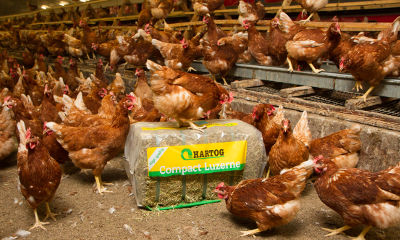
Laying hens that have access to Hartog Compact Lucerne during the rearing period benefit especially during the laying period. During the laying period, the hens often have a better plumage and foraging behavior has a positive effect on litter quality. An investment in roughage during rearing is well worthwhile. If the rearing hens are not predisposed to feather pecking, the young animals do learn to scavenge and take in roughage. This allows quicker correction during the laying period should the hens still be feather pecking. They know how to deal with the offered measures sooner than if they have not been taught this during rearing. Practice shows that the hens that were introduced to roughage in the rearing period, distribute themselves much better over the total area of the compartments during the laying period.
Good agreements between the breeding farm and the laying farm are therefore essential. Only with regular availability of Compact Lucerne during the rearing period will the hens learn natural foraging behavior. This reduces the chance that in a later period the hens will consume too much roughage, reduce the intake of concentrates and disturb the energy balance. Providing roughage is not only appropriate in the organic sector; the conventional sector also benefits from healthy laying hens. Lucerne has an early influence on the development of a healthy gizzard and healthy intestines. A better developed gizzard is more beneficial for laying hens, especially to prevent malnutrition when laying. Malnutrition can lead to problems such as poor production and fatty liver.
There are a number of periods in rearing when the risk of feather pecking increases. These are the first four weeks of rearing, the moulting periods and the periods when the amount of (day) light increases. It is therefore possible to offer the Compact Lucerne in small amounts on the chick paper on the grids during the first weeks. In the moulting periods, the hens’ plumage is sloppy, making feather pecking more likely. Long days with lots of light are a risk because boredom strikes hens after about 8 hours of scratching per day. In this case, a combination of Compact Lucerne with other distractions is recommended.
Receive the latest offers, exclusive content and news from Hartog Family Farms.

Grasdrogerij Hartog B.V.
Mijnsherenweg 7
1658 CA Lambertschaag
0229 – 58 12 32
info@hartog.eu